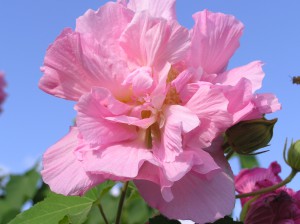What plant is found mostly in older landscapes but is poorly available in most local nurseries, is closely related to okra and cotton but is called a rose and produces showy fall flowers that turn from white to pink or red? Give up?
The plant is commonly called confederate rose. Some people call it cotton rose. Its botanical name is Hibiscus mutabilis.
Confederate roses usually begin blooming in late summer and continue to flower well into fall.
Even though it’s frequently referred to as confederate rose, it’s not a member of the rose (rosaceae) family. It belongs to the mallow (malvaceae) family, which includes numerous ornamentals, cotton and okra.
It is a true hibiscus. But, unlike many other ornamental hibiscus species, for some reason it is not usually found in most local garden centers. The plant finds its way into other landscapes simply by one gardener sharing a cutting with another gardener.
It’s easy to propagate. New plants can be started in spring from seed or from 8 inch long terminal cuttings taken during spring, summer and early fall. Cuttings can be rooted in a conventional propagation bed or even in a glass of water.
There are several forms of confederate roses. The cultivar known as ‘Rubus’ has deep pink flowers. ‘Plena’ has double white flowers that change to pink or red on the second day. The older, original types have double flowers that open white in the morning and gradually turn pink in the afternoon.
Even though confederate rose is not very impressive during spring and summer with its cotton or okra like leaves, you may find it a worthwhile landscape plant as it produces its large flowers (some up to 6 inches across) in late summer and fall.

With proper care, a confederate rose should grow into a 15-foot tall bush during a single season. But expect the entire plant to be killed to the ground during the winter. But it usually sprouts rapidly from the crown the following spring. Be careful, too much fertilizer can result in lots of leaves but few blooms.
 0
0
